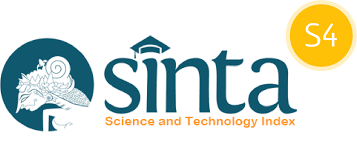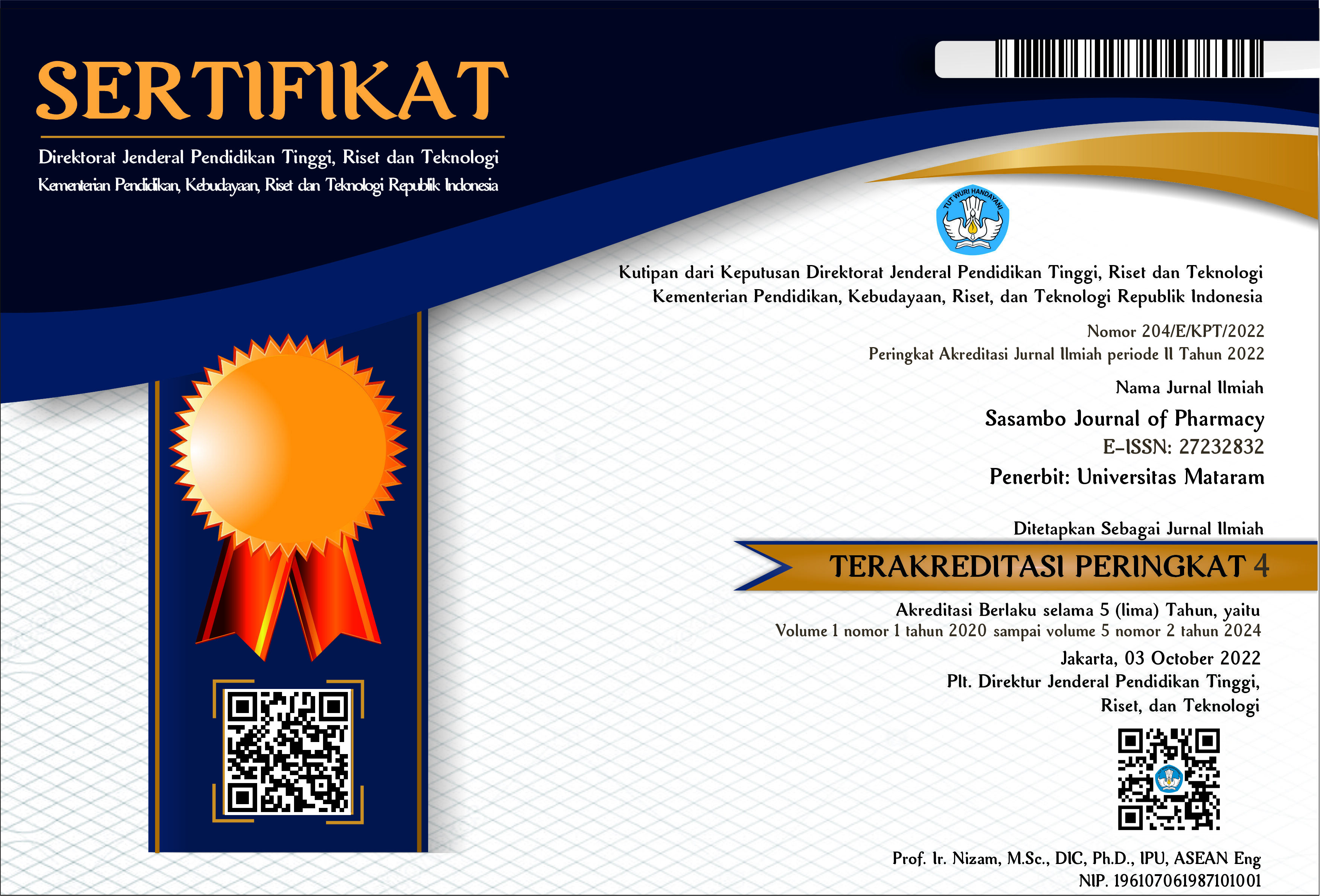Review artikel: validasi metode analisis kafein dalam minuman kemasan menggunakan berbagai instrumen
DOI:
10.29303/sjp.v6i2.598Downloads
Abstract
Caffeine is a central nervous system stimulant that is commonly found in packaged beverages. While moderate consumption provides cognitive and physical benefits, excessive intake may cause adverse health effects, including anxiety disorders, insomnia, cardiovascular diseases, and renal dysfunction. Consequently, accurate and validated analytical methods are essential for determining caffeine levels in commercial beverages. This review evaluates analytical instruments and techniques for caffeine quantification, drawing on national and international studies published between 2015 and 2025. The methods examined include UV-Visible Spectrophotometry, High-Performance Liquid Chromatography (HPLC), Gas Chromatography–Mass Spectrometry (GC–MS), Ultra-Performance Liquid Chromatography (UPLC), and High-Performance Thin-Layer Chromatography (HPTLC). Validation was assessed using parameters such as limit of detection (LOD), limit of quantification (LOQ), precision, accuracy, and linearity. The findings indicate that all methods meet acceptable validation criteria. Among them, UPLC demonstrated the highest sensitivity, while HPTLC provided advantages in speed and operational efficiency. Therefore, the choice of method for caffeine determination should be guided by analytical objectives, laboratory resources, and required sensitivity.
Keywords:
Caffeine, Method validation, UV-Visible Spectrophotometry, High-Performance Liquid Chromatography (HPLC), Gas Chromatography-Mass Spectrometry (GC-MS), Ultra-Performance Liquid Chromatography (UPLC), High-Performance Thin Layer Chromatography (HPTLC)References
Abbood, A., & Aldiab, D. (2017). HPLC determination of caffeine in some beverages and pharmaceutical dosage forms available in Syrian market. Journal of Chemical and Pharmaceutical Sciences, 3(10), 1174–1179. https://www.jchps.com/issues/Volume%2010_Issue%203/20171025_065816_0160217.pdf
Abriyani, E., Putri, N. S., Rosidah, R. S. N., & Ismanita, S. S. (2022). Analisis Kafein Menggunakan Metode Uv-Vis: Tinjauan Literatur. Jurnal Pendidikan Dan Konseling (JPDK), 4(6), 12732-12739. https://doi.org/10.31004/jpdk.v4i6.10610
Ahmad, W., Yusuf, M., Ahmad, A., Hassan, Y. A., Amir, M., & Wahab, S. (2022). Development and validation of ultra performance liquid chromatography (UPLC) method for the quantitative estimation of caffeine in non-alcoholic soft and energy drinks. Journal of AOAC International, 105(4), 1146-1152. https://doi.org/10.1093/jaoacint/qsac016
Al-Bratty, M., Alhazmi, H. A., Rehman, Z. U., Javed, S. A., Ahsan, W., Najmi, A., Khuwaja, G., Makeen, H. A., & Khalid, A. (2020). Determination of caffeine content in commercial energy beverages available in Saudi Arabian market by gas chromatography‐mass spectrometric analysis. Journal of Spectroscopy, 2020(1), 3716343. https://doi.org/10.1155/2020/3716343
Annuryanti, F., Zahroh, M., & Purwanto, D. A. (2018). Pengaruh Suhu dan Jumlah Penyeduhan terhadap Kadar Kafein Terlarut dalam Produk Teh Hijau Kering dengan Metode KCKT. Jurnal Farmasi Dan Ilmu Kefarmasian Indonesia, 5(1), 30-35.https://doi.org/10.20473/jfiki.v5i12018.30-35
Aprilia, S. A., Wonorahardjo, S., & Utomo, Y. (2023). Analysis of Flavor in Roasted Coffee Using Temperature Programmable Injection (TPI) at GC/MS Method. EKSAKTA: Journal of Sciences and Data Analysis, 46-53. https://doi.org/10.20885/EKSAKTA.vol4.iss1.art6
Ayuni, B. F. (2022). Validasi Metode Analisis Kafein pada Kopi Latte dengan Spektrofotometri Uv-Vis. Analit: Analytical and Environmental Chemistry, 155-164. https://doi.org/10.23960/aec.v7i02.2022.p155-164
BPOM RI. (2020). Keputusan Kepala Badan Pengawasan Obat dan Makanan Republik Indonesia Nomor HK.00.05.23.3644 tentang Ketentuan Pokok Pengawasan Suplemen Makanan. Badan Pengawas Obat dan Makanan Republik Indonesia. https://jdih.pom.go.id/
Chawla, G., & Ranjan, C. (2016). Principle, instrumentation, and applications of UPLC: A novel technique of liquid chromatography. Open Chemistry Journal, 3(1), 1-16. http://dx.doi.org/10.2174/1874842201603010001
Fajriana, N. H., & Fajriati, I. (2018). Analisis kadar kafein kopi Arabika (Coffea arabica L.) pada variasi temperatur sangrai secara spektrofotometri ultra violet. Analit: Analytical and Environmental Chemistry, 3(02). https://doi.org/10.23960/aec.v3i2.2018.p
Fatmawati, A., Sucianingsih, D., Lestari, Y., Fauzi, R., Emelda, E., & Munir, M. A. (2023). Analisis Kualitatif dan Kuantitatif Kandungan Asam Salisilat pada Sediaan Kosmetika Semi Padat yang Beredar di Pasar Beringharjo, Yogyakarta. INPHARNMED Journal (Indonesian Pharmacy and Natural Medicine Journal), 6(2),47-57. http://dx.doi.org/10.21927/inpharnmed.v6i2.1935
Foudah, A. I., Shakeel, F., Salkini, M. A., Alshehri, S., Ghoneim, M. M., & Alam, P. (2022). A green high-performance thin-layer chromatography method for the determination of caffeine in commercial energy drinks and formulations. Materials, 15(9), 2965. https://doi.org/10.3390/ma15092965
González, O., & Alonso, R. M. (2020). Validation of bioanalytical chromatographic methods for the quantification of drugs in biological fluids. In Methods of Therapeutic Drug Monitoring Including Pharmacogenetics (Vol. 7, pp. 115–134). Elsevier Science B.V. https://doi.org/10.1016/B978-0-444-64066-6.00006-X
Jiang, L., Qiu, Y., Chen, Z., Luo, L., Tang, H., Zhou, X., ... & Liu, P. (2022). Characterization of quality differences of Ophiopogonis Radix from different origins by TLC, HPLC, UHPLC-MS and multivariate statistical analyses. Journal of Liquid Chromatography & Related Technologies, 45(9-12), 120-129. https://doi.org/10.1080/10826076.2022.2159977
Kementerian Kesehatan Republik Indonesia. (2020). Farmakope Indonesia (Edisi VI). Jakarta: Kementerian Kesehatan Republik Indonesia. https://farmalkes.kemkes.go.id/
Kruse, J., Wörner, J., Schneider, J., Dörksen, H., & Pein-Hackelbusch, M. (2024). Methods for estimating the detection and quantification limits of key substances in beer maturation with electronic noses. Sensors, 24(11), 3520. https://doi.org/10.3390/s24113520
Lestari, A., Okzelia, S. D., & Wahyuni, W. (2023). Analisis Kadar Kafein pada Minuman Kopi Kekinian di Bekasi Timur dengan Metode Spektrofotometri UV-Vis. Jurnal Pharmascience, 10(2), 209-222. https://doi.org/10.20527/JPS.V10I2.14605
Margareta, M. A. H., & Wonorahardjo, S. (2024). Pengembangan Dan Validasi Metode Untuk Analisis Senyawa Kafein Menggunakan Instrumen Gas Chromatography-Mass Spectrum, Ultra Violet–Visible Dan Fourier Transform–Infra Red. Jurnal Penelitian Sains, 26(2), 239-246. https://doi.org/10.56064/jps.v26i2.1011
Mariana, E., Cahyono, E., Rahayu, E. F., & Nurcahyo, B. (2018). Validasi metode penetapan kuantitatif metanol dalam urin menggunakan gas chromatography-Flame ionization detector. Indonesian Journal of Chemical Science, 7(3), 277-284. https://doi.org/10.15294/ijcs.v7i3.25608
Medina, I. Y., Rodriguez, D. C., & Parra, J. W. (2020, July). Analysis of caffeine in energy drinks by ultra-fast liquid chromatography. In Journal of Physics: Conference Series (Vol. 1587, No. 1, p. 012024). IOP Publishing. https://doi.org/10.1088/1742-6596/1587/1/012024
Legas Muhammed, B., Hussen, M. S., & Habte, A. T. (2021). Determination of caffeine and hydrogen peroxide antioxidant activity of raw and roasted coffee beans around Habru Woreda, Ethiopia using UV-Vis spectrophotometry. Clinical Pharmacology: Advances and Applications, 13, 101–113. https://doi.org/10.2147/CPAA.S311032
Naveen, P., Lingaraju, H. B., Deepak, M., Medhini, B., & Prasad, K. S. (2018). Method development and validation for the determination of caffeine: an alkaloid from coffea arabica by high-performance liquid chromatography method. Pharmacognosy research, 10(1), 88. https://doi.org/10.4103/pr.pr_79_17
Nurhidayanti, N., Munir, M. A., Emelda, E., & Fatmawati, A. (2024). Analisis kafein pada minuman kemasan menggunakan metode kromatografi lapis tipis (KLT) dan spektrofotometri. Stannum: Jurnal Sains dan Terapan Kimia, 6(1), 28–35. https://doi.org/10.33019/jstk.v6i1.4564
Riyanto. (2014). Validasi & verifikasi metode uji: Sesuai dengan ISO/IEC 17025 laboratorium pengujian dan kalibrasi. Yogyakarta: Deepublish.
Rupa, N. F., Gama, S. I., & Ahmad, I. (2023, December). Validasi Metode dan Penetapan Kadar Kafein Menggunakan Spektrofotometri UV-Vis. In Proceeding of Mulawarman Pharmaceuticals Conferences (Vol. 18, pp. 109-115). https://doi.org/10.30872/mpc.v18i.236
Saputri, F. A., & Muchtaridi, M. (2018). Analytical method development and validation for the determination of caffeine in green coffee beans (Coffea arabica l.) from three districts of west java, indonesia by high performance liquid chromatography. Int J App Pharm, 10(6), 107-111. http://dx.doi.org/10.22159/ijap.2018v10i6.28551
Sheliya, K. G., & Shah, K. V. (2013). Ultra performance liquid chromatography (UPLC): A modern chromatography technique. Pharma Science Monitor, 4(3). http://www.pharmasm.com
Shrestha, S., Rijal, S. K., Pokhrel, P., & Rai, K. P. (2016). A simple HPLC method for determination of caffeine content in tea and coffee. Journal of Food Science and Technology Nepal, 9, 74–78. https://doi.org/10.3126/jfstn.v9i0.16200
Shrivastava, A., & Gupta, V. B. (2011). Methods for the determination of limit of detection and limit of quantitation of the analytical methods. Chron. Young Sci, 2(1), 21-25. https://doi.org/10.4103/2229-5186.79345
Suhartati, T. (2017). Dasar-dasar spektrofotometri UV-Vis dan spektrometri massa untuk penentuan struktur senyawa organik. Lampung: Anugrah Utama Raharja.
Susanti, H., Araaf, N. P. M., & Kusbandari, A. (2020). Perbandingan metode spektrofotometri UV dan hplc pada penetapan kadar kafein dalam kopi. Majalah Farmasetika, 4, 28-33. https://dx.doi.org/10.24198/mfarmasetika.v4i0.25887
U.S. Food & Drug Administration. (2019). Guideline for the validation of chemical methods in food, feed, cosmetics, and veterinary products (3rd ed.). U.S. Food & Drug Administration. https://www.fda.gov
Susanti, M., & Dachriyanus. (2017). Kromatografi cair kinerja tinggi. Padang: Andalas University Press.
Wonorahardjo, S. (2013). Metode-Metode Pemisahan Kimia. Jakarta: Akademia Permata.
Wulansari, S. A., & Lubada, E. I. (2020). Validasi metode analisa pada penetapan kadar koenzim Q10 dalam sediaan mikroemulsi menggunakan metode spektrophotometer UV-Vis. Jurnal Kimia Riset, 5(1), 29–35. https://doi.org/10.20473/jkr.v5i1.19241
License
Copyright (c) 2025 The Author(s)

This work is licensed under a Creative Commons Attribution 4.0 International License.
Authors who publish with Sasambo Journal of Pharmacy (SJP), agree to the following terms:
- Authors retain copyright and grant the journal right of first publication with the work simultaneously licensed under a Lisensi Creative Commons Atribusi 4.0 Internasional. This license allows authors to use all articles, data sets, graphics and appendices in data mining applications, search engines, web sites, blogs, and other platforms by providing an appropriate reference. The journal allows the author(s) to hold the copyright without restrictions and will retain publishing rights without restrictions.
- Authors are able to enter into separate, additional contractual arrangements for the non-exclusive distribution of the journal's published version of the work (e.g., post it to an institutional repository or publish it in a book), with an acknowledgment of its initial publication in Sasambo Journal of Pharmacy
- Authors are permitted and encouraged to post their work online (e.g., in institutional repositories or on their website) prior to and during the submission process, as it can lead to productive exchanges, as well as earlier and greater citation of published work (See The Effect of Open Access).







